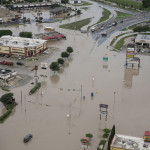New Study Warns of Extreme Sea Level Rise Event for US East Coast
Rapid rise of sea levels along the east coast of the United States has prompted scientists at the University of Arizona to publish a study with a warning.
The report, published in the journal Nature Communications, warned that coastal areas would need to prepare for ‘extreme’ sea-level events. (See Video Below)
Sea levels along the north-east coast of America rose almost four inches (10.16 cm) in just two years, a report has revealed.
The record increase north of New York City between 2009 and 2010 is being described by experts as an ‘unprecedented’ one in 850-year event.
And in Portland, Maine, sea levels rose by five inches (12.7 cm) over the same two year period, researchers found.
Professor Jianjun Yin of the University of Arizona told the BBC: ‘The extreme sea level rise event during 2009-10 along the northeast coast of North America is unprecedented during the past century.
‘When coastal storms occur, extreme sea levels can lead to elevated storm surge. ‘In addition to long-term and gradual sea level rise, coastal communities will need to prepare for short and extreme sea level rise events.’
The researcher told the Washington Post that the sea level had dropped following the spike but that it was still ‘much higher’ than when the spike started in 2009. He added that global warming ‘definitely contributed to this event.’
The website points to the unusually high tides that were widely reported in 2009 and 2010 from North Carolina’s Cape Hatteras to Canada.
The study’s authors wrote that in terms of beach erosion, the 2009-2010 sea rise was ‘almost as significant as some of the hurricane events’. The quickest jump in sea levels took place between April 2009 and March 2010, it says.
One of the researchers, Paul Goddard, added: ‘The sea level rise of 2009-2010 sticks out like a sore thumb for the Northeast.’
Researchers believe it was caused by a 30 per cent slowdown in a key ocean current system called the Atlantic Meridional Overturning Circulation (AMOC), as well as changes in atmospheric pressure at sea level, the Huffington Post reported.
The study used information gathered from a series of tide gauges along the east coast with the four inch rise taken from the average of 14 gauges between Canada and New York.







